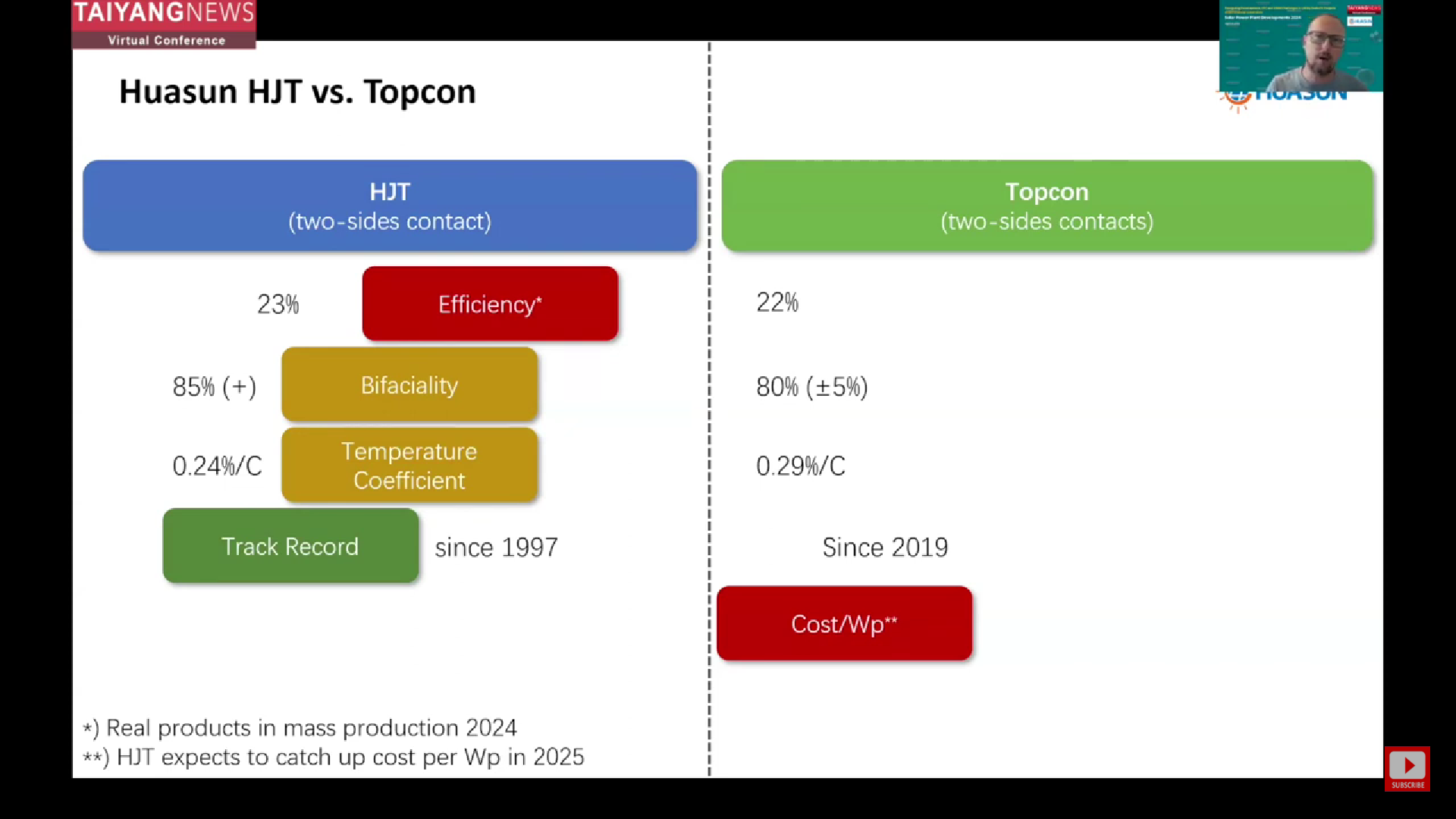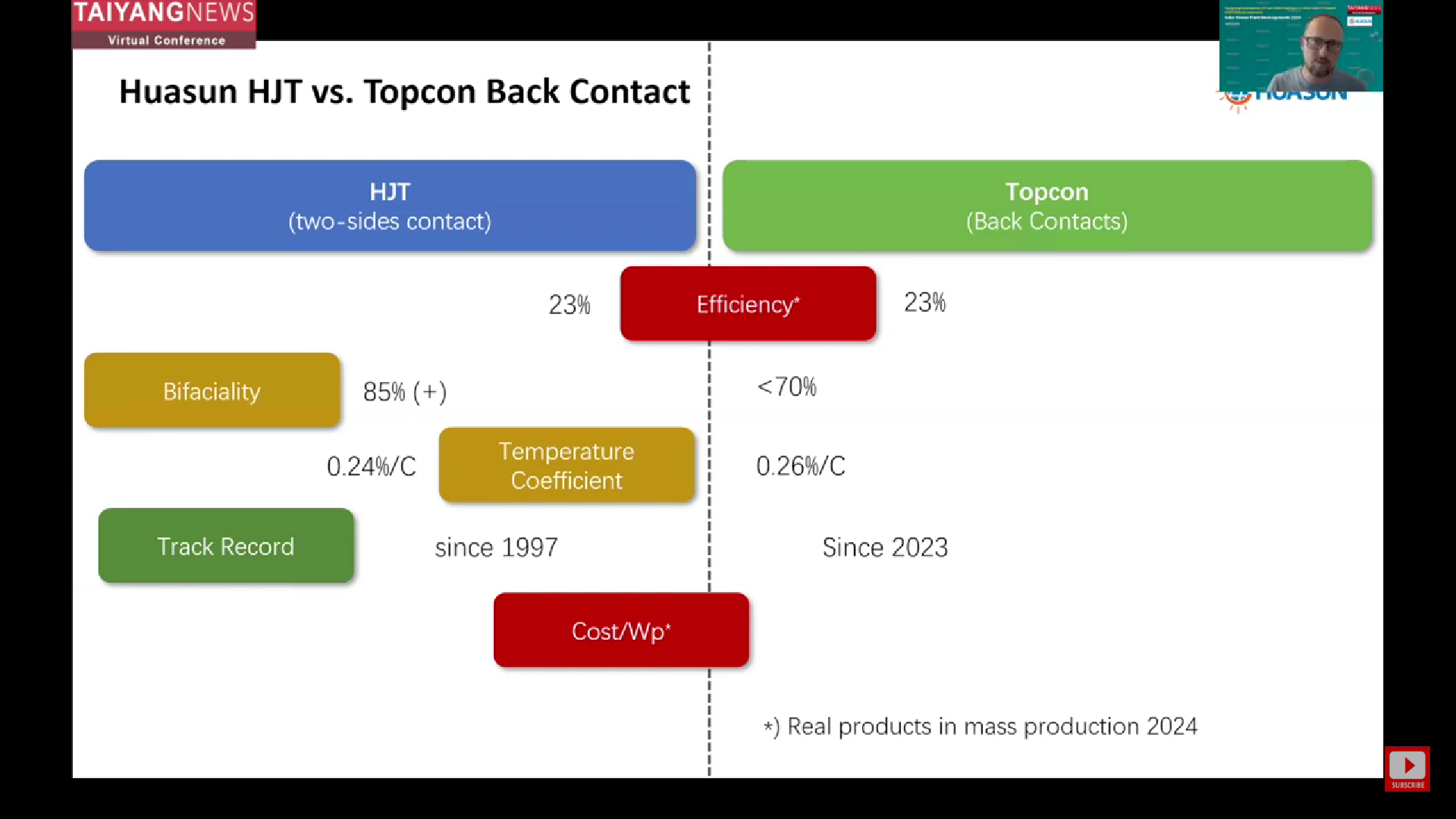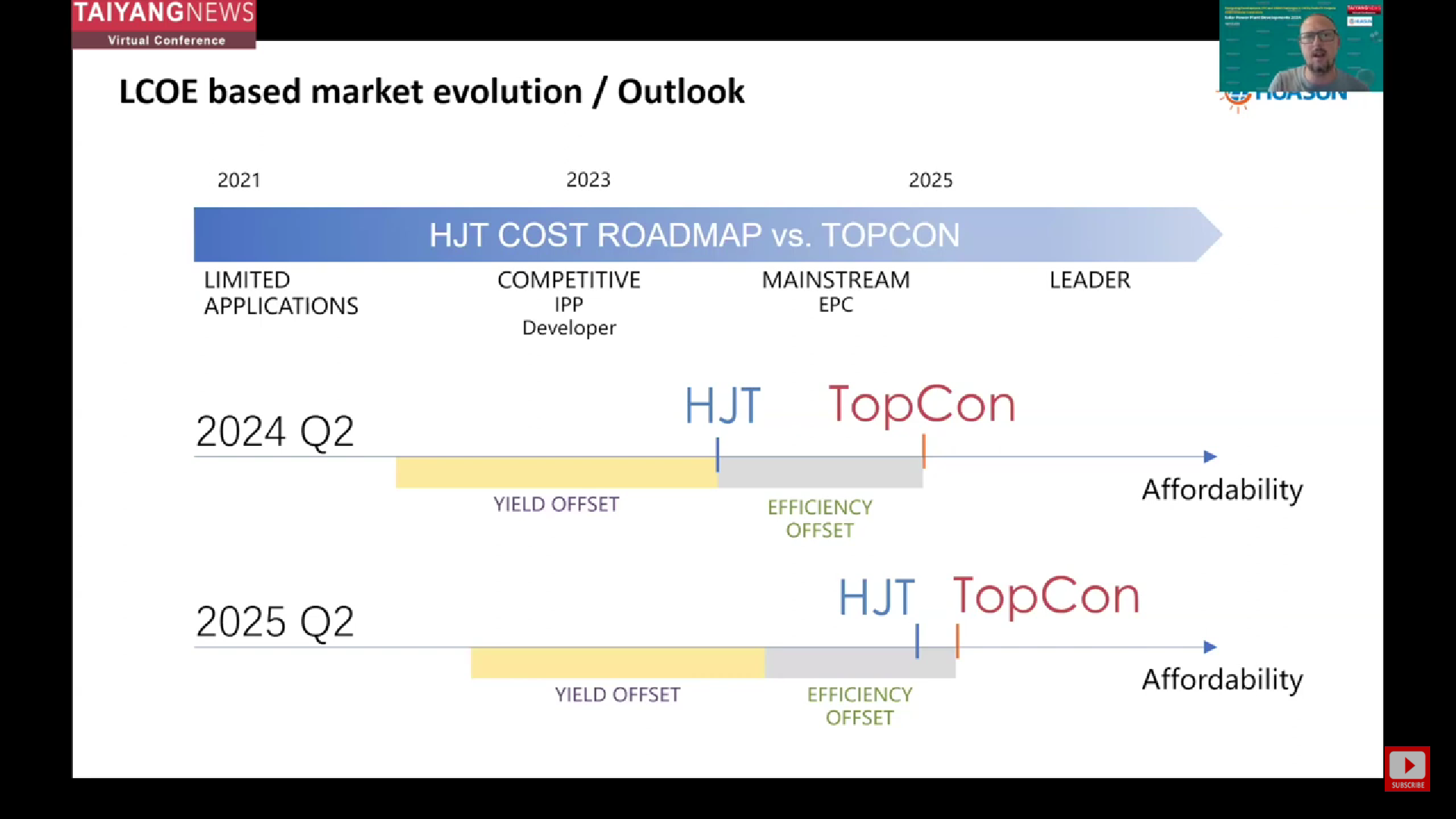- In Q2/2024, Huasun HJT module was 1.5c/W costly compared to TOPCon module, but the manufacturer believes it can be offset by higher efficiency and reduced BoS cost
- Despite slightly higher efficiency and lower temperature coefficient, lower bifaciality of TOPCon back contact module compared to HJT, does not create a level playing field in utility application
- Huasun has implemented multiple technological advancements at cell and module level, namely UV LCF, PIB sealant, 2 x µC-Si layer, and 0BB metallization
In the current global context of cell technology transition from P-type PERC to n-type high-efficiency cell structure, tunnel-oxide passivated contact (TOPCon) and heterojunction (HJT) technology routes are the frontrunners. TOPCon’s inherent production cost competitiveness paved the way for its mass adoption, resulting in the underestimation of HJT’s potential as a mainstream cell technology for utility projects.
At the recently concluded TaiyangNews Virtual Conference on Solar Power Plant Developments 2024, the Director of Business Development Europe at Huasun Energy, Christian Comes, provided a comparative analysis of HJT technology against its competitors, highlighting its lower LCOE for utility projects. (See Huasun’s presentation here)
Comes pointed out that for utility projects, minimizing LCOE involves managing key variables like cell efficiency, cost of installation, and price premium coupled with long-term durability.
Matching TOPCon LCOE
In pursuit of matching LCOE of a TOPCon utility project, Huasun HJT module’s current cost premium of 1.5c/W can be compensated with its lower installation cost, higher power yield, and higher efficiency, said Comes. He substantiated his claims by a PVSyst simulation data for a 100 MW, 1P tracker-based bifacial utility-scale project at a Spanish site with 25% albedo. Comparing the critical characteristics of HJT cell technology that influence a utility project’s LCOE, Huasun’s 23% mass-produced module efficiency in comparison to TOPCon’s standard 22%, offers higher power yield from the same size of module. The high-power yield of HJT can also be attributed to its high bifaciality of 85% without any error margin like TOPCon’s +/- 5%, and low-temperature coefficient of -0.24%/°C, he explained. He emphasized that its current 24BB-based 100 µm thick cell has further scope for lowering the temperature coefficient in sync with the wafer thinning process.

Alongside the critical characteristics, Huasun’s HJT module’s quality BoM and manufacturing process ensure long-term durability with assured power yield from utility projects. Taking lessons from HJT technology’s proven track record of more than 2 decades, Huasun has implemented multiple technological advancements at both cell and module levels – UV light conversion film (UV LCF), PIB sealant, microcrystalline polysilicon layer on top of amorphous silicon layer (2 x µC-Si), and busbarless (0BB) metallization. The replacement of EVA with UV LCF, made with an additive into the encapsulant, improves the efficiency and reliability of the module by transforming incoming UV light into visible light. Comes claimed that the UV LCF-based HJT module is new in utility application, though the encapsulant has 15 years of proven track record of properly transforming UV light into visible light for the module’s entire lifetime. Huasun ensures its module’s resilience against humidity ingress by including PIB at the module edges compounded with front and back side glass cover, shared Comes. The company claims its modules with PIB edge sealant show 10 times higher resilience against humidity ingression compared to POE. On HJT cell side, it has implemented microcrystalline polysilicon layer on top of amorphous silicon layer (2 x µC-Si), boosting cell efficiency significantly. In addition, the manufacturer has adopted cost-effective and reliable metallization technology – busbarless (0BB) metallization. In this technology, the soldering ribbon is glued on top of the cell instead of soldering on specified points, leading to thinner finger, reduced silver consumption, improved reliability, and scope for more thinner wafer. Comes commented that busbarless metallization on TOPCon cell structure would take longer to materialize due to its inherent drawback of copper metal particle ingress inside the cell’s bulk substrate.
By 2025, Huasun expects to have a HJT module cost to perfectly match the cost of TOPCon with more technological advancement and over 40 GW integrated manufacturing capacity.
TOPCon – all contacts on backside
Shifting all front side current carrying contacts to the back side of the TOPCon cell also become mainstream in global market, according to Comes. Despite the slightly higher efficiency and lower temperature coefficient of back-contact TOPCon technology compared to HJT, its lower bifaciality in glass-to-glass modules is a major disadvantage for utility scale projects. Thus, TOPCon back contact modules do not have any high stake in utility application.

Technology roadmap
Showing confidence in the future of perovskite HJT tandem cell structure, Huasun is optimistic to have its 1st module size tandem sample ready by next year. Although the perovskite tandem has an incredible effect on cell efficiency and very good effect on cost, the reliability is still a question mark, cautioned Comes. Huasun expects to have perovskite tandem cell of 28% and 29% efficiency in mass production between 2026 and 2027.


